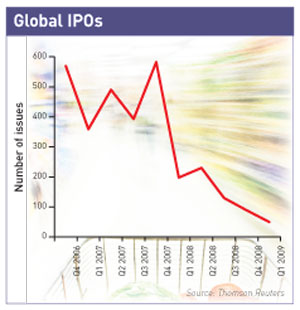Due to the limited number of IPO issues stock exchanges have had to get competitive. Many, such as NASDAQ and NYSE, have teamed up with suppliers to provide discounted IRO services
The downturn has halted the pre-recession stock exchange boom. Coupled with an IPO market at its slackest for more than 10 years, this has left bourses raising their game in a bid to win new listings – and retain existing ones. Data from Thomson Reuters shows global IPO issues reached an 11-year low in the first quarter of 2009, raising $1.38 bn in new issues (see Global IPOs, right). While the downturn has marked a period of difficult transition for stock exchanges around the world, it has also generated significant opportunities, and the upside of the ultra-competitive environment is that listed companies are getting more for their dollar. In addition to more competitive listing fees, corporates are starting to enjoy the benefits of discounts on their IR services, ranging from training and development to roadshows and capital markets days.
Data from Thomson Reuters shows global IPO issues reached an 11-year low in the first quarter of 2009, raising $1.38 bn in new issues (see Global IPOs, right). While the downturn has marked a period of difficult transition for stock exchanges around the world, it has also generated significant opportunities, and the upside of the ultra-competitive environment is that listed companies are getting more for their dollar. In addition to more competitive listing fees, corporates are starting to enjoy the benefits of discounts on their IR services, ranging from training and development to roadshows and capital markets days.
Some exchanges offer services directly, others farm the work out to specialist providers by way of partnerships and agreements. Arguably, exchanges in North America have led the way in teaming up with service providers. Toronto Stock Exchange (TSX), NASDAQ and the NYSE have all entered into agreements of some sort to offer IR services.
Market intelligence
TSX formed a strategic alliance with Thomson Financial and launched TSX Connect in 2006 before acquiring IR firm Equicom in 2007. Equicom provides a range of IR support services including IPO roadshows and annual and quarterly report production to listed Toronto firms.
As you’d expect from a stock exchange with a technological focus, NASDAQ has also been a leader in this area, acquiring Shareholder.com in 2006 and launching its own Market Intelligence Desk (MID).
According to the exchange, MID has a range of functions from determining which brokers are most active in a company’s stock to properly assisting companies with their stock buybacks and monitoring real-time data.
Cost concerns
‘The way we see it, it saves time and dollars, and can help minimize errors,’ explains Bradley Smith, director of marketing at Shareholder.com, a NASDAQ OMX company. ‘If your webcasting provider is different from your news disseminator, you have to replicate work. This way, if you send a press release through NASDAQ-owned GlobeNewswire, for example, it is automatically sent to Shareholder.com, and vice versa.’
The extras don’t always come free, however. Like several other stock exchanges, NASDAQ offers issuers its core services gratis, and then charges for the other facilities. ‘Issuers get four webcasts a year and one 2,000-word press release as part of their core deal,’ Smith says.
On the back of developments at NASDAQ, the NYSE launched its own Market Access Center in September 2008. The exchange’s core market intelligence service for companies uses data gathered by risk consultancy Eurasia and intelligence provider Medley Global Advisors.
‘We wanted to provide round-the-clock coverage and market expertise as part of our complementary offering,’ notes Theresa Molloy, vice president of corporate client services at the NYSE.
In November 2008 the exchange also teamed up with Ipreo and NYSE-listed Thomson Reuters to offer a greater range of IR services to issuers. The deal gives companies the opportunity to enjoy discounts on a range of IR services such as stock surveillance, IR websites and webcasting.
Like several other agreements between exchanges and service providers, however, the deal has ruffled feathers. Other vendors claim they have, in effect, been frozen out by this move and call it unhelpful to issuers that want to maintain relationships with their existing providers.
Not all exchanges are acquiring consultants and striking big deals with suppliers, however. The Deutsche Börse makes Thomson FactSet data accessible to issuers but offers what it calls independent advice to issuers to help them choose a consultant.
‘We give guidance to IROs to help them find the best consultant for their needs,’ explains Martin Steinbach, head of issuer and investor markets at Deutsche Börse. ‘Our Listing Partners scheme gives unbiased advice to issuers while allowing the company to pick the consultant that best suits them.’
Research offerings
Sell-side research has always been a useful tool to help issuers get on investors’ radar. Over the past few years, demand for issuer-sponsored equity research has skyrocketed. But the model suffers from drawbacks such as high costs and concerns over the independence of the research. In recognition of this, exchanges have started offering equity research with varying degrees of success.
In Malaysia and Singapore, for example, research is conducted by an external broker, which helps to improve the visibility of the firms participating in the program. Bursa Malaysia collaborates with the country’s Capital Market Development Fund to subsidize the cost of research by 50 percent.
‘Between 2004 and 2007, a grand total of 303 listed companies and 21 research houses participated in the scheme,’ comments Eddie Razak, chief executive of the Malaysian Investor Relations Association.
A similar scheme works in nearby Singapore as part of the post-IPO process. SGX’s Research Incentive Scheme provides research coverage of listed companies by independent research houses, a service subsidized by the exchange. ‘There are plans to enhance this scheme in the future by using a more segmented approach,’ comments Lawrence Wong, executive vice president and head of listings at SGX.
In contrast to the broker research model currently offered by Bursa Malaysia and SGX, NASDAQ attempted a research scheme in 2004 with the launch of its Independent Research Network (IRN), a joint venture between NASDAQ and Reuters. ‘The idea of the IRN was to establish a panel of research providers and have those providers allocated by an expert committee to ensure research was independent,’ explains Shane Smith, chairman and chief executive at UK research company Independent International Investment Research.
Ultimately, however, the high-price tag proved prohibitive and the venture was wound up last year after failing to attract sufficient support from issuers. ‘The rigor of the framework was first class – there was no way any firm could complain about the way the research firm was assigned,’ Shane Smith says. ‘The problem was the cost: issuers simply couldn’t afford it.’
Shane Smith’s research firm is one of three equity research houses that is part of PSQ Analytics, the London Stock Exchange’s (LSE) new equity research offering for small and mid-cap firms.
The new product represents the first time the London exchange has offered research to companies, and the backers hope the lower price tag will help garner attention from issuers. ‘Because of the economies of scale, costs are significantly lower for issuers,’ Shane Smith adds.
The LSE is pitching to companies outside the FTSE 250, most of which have zero coverage unless they sign up for a sponsored research model available from providers such as Edison, Hardman and Equity Development, the bills for which can run into tens of thousands of pounds.
The model was developed by the LSE and works by assigning one of the three research firms to each paid-up issuer. ‘It’s an automatic allocation – it assigns one of the three of us so it eliminates the opportunity for issuers to go out and cherry-pick a research firm,’ Shane Smith explains.
Quality and choice
Stock exchanges have shown a genuine concern for improving the quality of investor relations at their listed companies. Bursa Malaysia’s free program to improve online IR portals, which is targeted at smaller firms that can struggle with IR, is one such initiative.
Never before have listed companies been able to choose from such a range of sophisticated and cost-effective offerings. The increase in competition can only be good news for issuers, many of whom are already struggling with dwindling budgets.
The key challenge for the future will be maintaining this wide range of choices as suppliers’ margins decrease in the long term.
Additional reporting by Carolyn Sterling










